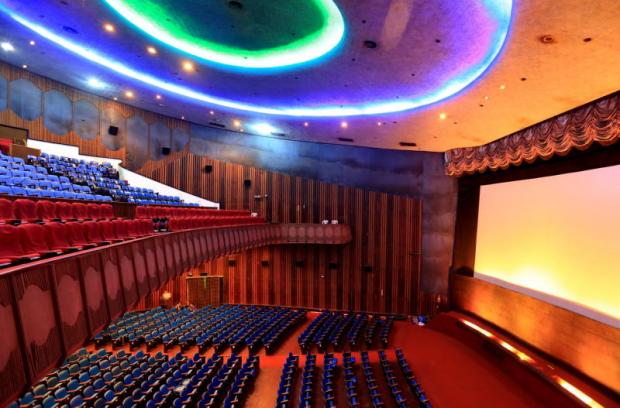Going to the movies in 21st century Myanmar is an experience little changed from the last century. With a majority of the country's cinema screens still located in stand-alone movie theatres built between the late 1940s and early 1960s, Myanmar has become a movie-going anomaly among its Asean neighbours, one of the many unintended consequences of decades of economic isolation. But judging by the business model of the country's biggest cinema chain, it's an anomaly worth preserving.
Yangon-based Mingalar Cinemas is indeed unusual for a leading national movie theatre chain. Like most other cinema chains in Southeast Asia, it too is expanding. But unlike others however -- say in Thailand -- which grow their operations by developing multiplexes coupled with bulky shopping malls, Mingalar is taking an approach that honours Myanmar's impressive architectural history: it restores classic stand-alone cinemas.
"We have an affinity with the old stand-alone movie theatres," said a senior Mingalar representative. "Myanmar once had a strong cinema industry, so we have many high quality ones."
Since Mingalar Cinemas was founded in 1994, the company has purchased or leased 11 vintage cinemas. Nine of them are in use, with two being renovated. In each case, the preservation-minded company has updated the important technical components -- audio, projection and seating -- while ensuring that the cinema's original architecture remains uncompromised as much as possible.
In a few cases, Mingalar has reconfigured an existing cinema from a single screen to multiplex, but those are the exception rather than the norm.
Last year, Mingalar acquired the San Pya Cinema, a stately old stand-alone cinema in downtown Yangon that had fallen into disrepair. Instead of tearing it down for redevelopment, Mingalar opted to carve three small screening rooms out of the once grand single-screen auditorium, preserving the theatre's sleek international style exterior.
"We tried to keep the facade as original as possible," said the company representative, conceding that only a change of colour was made as a signal to the community that the cinema had been improved.
Sensitive treatment of a long-established structure maintains the streetscape's historic continuity, while increasing reserves of cultural capital for the city at large.
In the heavily industrialised suburb of Hlaing Thayar Township, Mingalar recently took over The Waziya 2 Cinema, one of a handful of government-constructed cinemas erected in the early 1990s. The Waziya 2 was shut for several years before Mingalar came to the rescue. "At first we thought we would divide the single-screen auditorium into three small ones," said the company representative, "but in the end we opted to keep it as one in order to accommodate larger crowds".
Since installing top-of-the-line Christie 4K Digital Projectors and Dolby Digital Sound, the new and improved 615-seat Minaglar Waziya Cinema is doing better than ever.
"It's a good thing we kept the auditorium whole," mused the representative. "On weekends, the theatre is usually packed."
Besides their six resuscitated stand-alones in Yangon, including the company's flagship Thamada Cinema, one of Southeast Asia's finest examples of mid-century cinema architecture, Mingalar's holdings stretch to Mandalay and Pyay, with more acquisitions slated for Magwe and Pegu.
"People in Myanmar are very brand conscious," said the Mingalar representative. "Those who watch movies at, say, the Thamada, only watch movies at the Thamada. The theatre names have goodwill and identity. They're part of the culture and lifestyle."
Mingalar's progressive stance on architectural preservation goes hand in hand with their acknowledgment of contemporary realities. In addition to revamping vintage cinema halls, Mingalar has teamed up with shopping mall operators to develop the more common mall-based multiplexes -- the standard cinema form of the 21st century.
When asked if Mingalar foresaw a future in which their mall-based branches would outnumber their classic venues, the company rep responded with a confident "No".
"Our market situation is unique," he explained. "We'll always be hybrid."
Mingalar's preservationist approach to expansion benefits Myanmar's cities, ensuring that at least some urban areas retain a level of architectural diversity in cinema form. That same diversity is quickly being lost in Thai cities, where historic cinemas continue to be treated like yesterday's garbage. While grassroots campaigns to revive a few of them have recently gained traction, Thailand's two largest cinema chains -- Major Cineplex and SF Cinema -- have shown no interest in preserving any of Thailand's cinema history.
As generational shifts in Thailand give way to changes in lifestyle -- led by the coming of age of the millennials and their consumer inclination for vintage, local and sustainable products -- it stands to reason that some of Thailand's cinema treasures could find a young new support base if properly restored.
Major and SF, then, could bolster their impressive resumes by reviving the ones in the most viable markets that stand the best chance of succeeding. Were Thailand's two biggest cinema operators develop a "heritage" or "vintage" lines -- in addition to their standardised multiplexes -- they would gain corporate social responsibility credit by helping to make Thai cities more culturally dynamic.
Until then, Myanmar's Mingalar Cinemas will stand alone among regional exhibitors in their efforts to prove that a top notch cinema experience and historic preservation can indeed coexist.
Philip Jablon is an independent researcher and photographer affiliated with Chiang Mai University. His Southeast Asia Movie Theater Project can be seen at www.seatheater.blogspot.com

Nay Pyi Daw Cinema in Yangon, Myanmar.

The San Pya Cinema in 2010, before Mingalar renovated it.

The Thamada Cinema balcony view in Yangon.

